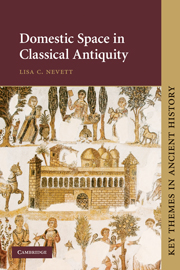Book contents
- Frontmatter
- Contents
- List of figures
- List of plates
- Preface and acknowledgements
- Map showing the locations of the sites and regions discussed in Chapters 3–6
- Introduction
- 1 Domestic space and social organisation
- 2 House-form and social complexity: the transformation of Early Iron Age Greece
- 3 A space for ‘hurling the furniture’? Architecture and the development of Greek domestic symposia
- 4 Housing and cultural identity: Delos, between Greece and Rome
- 5 Seeking the domus behind the dominus in Roman Pompeii: artefact distributions as evidence for the various social groups
- 6 Housing as symbol: elite self-presentation in North Africa under Roman rule
- Epilogue: domestic space and social organisation in Classical Antiquity
- Glossary
- Period names and dates referred to in this book
- Bibliographic essay
- Bibliography
- Index
5 - Seeking the domus behind the dominus in Roman Pompeii: artefact distributions as evidence for the various social groups
Published online by Cambridge University Press: 05 August 2012
- Frontmatter
- Contents
- List of figures
- List of plates
- Preface and acknowledgements
- Map showing the locations of the sites and regions discussed in Chapters 3–6
- Introduction
- 1 Domestic space and social organisation
- 2 House-form and social complexity: the transformation of Early Iron Age Greece
- 3 A space for ‘hurling the furniture’? Architecture and the development of Greek domestic symposia
- 4 Housing and cultural identity: Delos, between Greece and Rome
- 5 Seeking the domus behind the dominus in Roman Pompeii: artefact distributions as evidence for the various social groups
- 6 Housing as symbol: elite self-presentation in North Africa under Roman rule
- Epilogue: domestic space and social organisation in Classical Antiquity
- Glossary
- Period names and dates referred to in this book
- Bibliographic essay
- Bibliography
- Index
Summary
Bankers and tax collectors should have larger and more beautiful houses, safe from burglars. Public figures and speakers should have elegant and spacious accommodation to receive their visitors. For the true aristocracy who hold office and magistracies, and who must take on state roles, we must build high and stately anterooms, and very spacious atria and peristyles, along with wide groves and walkways completed in a majestic style; in addition we must build libraries, galleries and basilicas fitted out with a magnificence similar to that of public buildings.
Vitruvius, On Architecture 6.5.2–3All members of a society are contributors to the matrix of actions that eventually becomes the archaeological context, and the variety of features is a product of this activity…many archaeological features are diffuse, mixed and difficult to interpret. Some, though, are more likely than others to provide information on small group activities; among these are features with rather structured event and/or episode sets, such as houses…
Brooks 1982, 68–69INTRODUCTION
In relative contrast with the houses discussed in the other chapters of this volume, those from the Roman town of Pompeii have been intensively studied for more than 200 years, and it is easy to see why they have attracted so much attention. The Campania region of southern Italy in which they lie was covered in volcanic material by the eruption of Vesuvius in August 79 ce.
- Type
- Chapter
- Information
- Domestic Space in Classical Antiquity , pp. 89 - 118Publisher: Cambridge University PressPrint publication year: 2010



